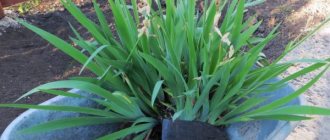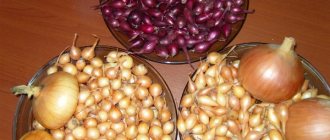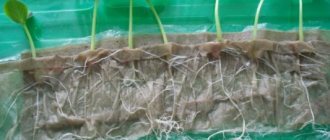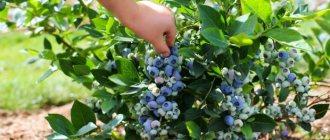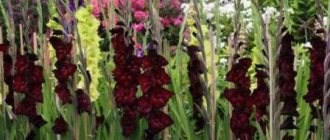Planting cucumbers in open ground with seeds in 2019 carried out according to certain rules, which will be discussed in this article.
Cucumbers have an excellent taste and are constantly used in human menus. This vegetable can be found in any garden, even on balconies and window sills, due to its ease of cultivation. However, beginning gardeners are not always able to grow this unpretentious crop using the seedless method.
Basically, the cause of failure is improper seed preparation and errors during the planting procedure itself. Caring for young shoots is also important. However, this problem is easily solved if you adhere to simple but very important rules. Let's talk in more detail about how to plant cucumbers with seeds in open ground .
When to plant cucumber seeds in open ground: optimal sowing time
Cucumbers belong to the pumpkin family and love warmth. Therefore, it is recommended to start sowing cucumber seeds on the plot after the ground has warmed up to at least +12 degrees. In this case, the air temperature should already be +14 degrees and above.
Important! Previously, seeds were not planted in open ground, since in cold weather the seeds simply would not be able to germinate. And in a damp and cold environment, the seed may simply die and not sprout.
At the same time, you should not delay sowing. Cucumbers develop at a temperature of +14+30 degrees, and do not tolerate extreme heat. Therefore, the period of active growth of the plant should not coincide with the July heat, otherwise the cucumbers will stop their development and may dry out altogether.
Important! But in a greenhouse you can start planting cucumber seeds 10-14 days earlier, since there the earth warms up faster.
Depending on region and climate
It is worth noting that the timing of sowing cucumber seeds in open ground is different in different regions of the country. In this case, when choosing the time for sowing cucumbers, it is necessary to take into account the climate characteristics of the region:
- Middle zone (Moscow region) - from May 10 to May 30.
- North-West of the country (Leningrad region) - in early June.
- Ural and Siberia. Due to the harsher climate in these regions, seed sowing begins from May 15 to the first days of June. Considering that summer is short in the cold regions of the country, cucumbers are often grown here using the seedling method.
- South - from April 15.
There are early-ripening, mid-ripening and late-ripening varieties of cucumbers. If you immediately sow varieties of cucumbers with different ripening periods on your plot, you can enjoy these vegetables throughout the season.
According to the recommendations of the manufacturers, depending on the variety
When buying cucumber seeds in a specialized store, you should pay attention to the recommendations that are on all packages. Here you can find specific dates for planting cucumbers of the variety you purchased.
According to the lunar calendar in 2021
Many gardeners use the lunar calendar to choose the day to plant seeds in open ground. The moon can influence the development of plants. It is believed that it is best to plant cucumbers during the waxing moon.
- April: 6-9, 11-13, 20, 21, 24-26, 29-30.
- May: 3, 4, 8-10, 17-18, 21-23, 26-28, 31.
- June: 5, 6, 13-15, 18-20.
Also, you need to take into account that there are also unfavorable days for planting cucumber seeds in open ground.
- April - 5, 19.
- May - 5, 19.
- June — 3, 4, 17
- July - 2, 3, 17.
Pros and cons of growing cucumbers in open ground
Not all gardeners have the opportunity to install a greenhouse or even a hotbed on their property. There can be a lot of reasons, but the result is the same - cucumbers have to be planted directly in open ground. But practice has shown that to get a tasty harvest, you can plant cucumbers with seeds without using peat tablets or cups.
By the way, read the article about what to choose a heifer or greenhouse for cucumbers and how to build them.
Some gardeners fundamentally adhere to the position that there is nothing better than vegetables grown in the open air. True, here the result depends on the vagaries of nature.
Sudden frosts or heavy rains with cold weather can ruin all planting efforts. This is the main disadvantage of the method. In addition, people who occasionally visit their dachas also risk being left without a harvest if their cucumbers sit in open ground, since it is very difficult to predict weather conditions. The sun will dry the soil under cover, and precipitation will lead to rotting.
But in contrast to this, there are also advantages of planting in open ground:
- no costs for building a greenhouse;
- there is no need to carry out annual treatment of the premises where vegetables are to be grown;
- you can significantly expand the planting area without being limited to the walls of the structure;
- It is possible to plant a large number of different varieties.
Hardening
If you plan to plant seedlings outdoors, they need to be hardened off a week before. To do this, you need to open the windows in the room every day throughout the week, first for a couple of hours, then adding 2-3 hours every day. For the last few days, you can keep the windows open around the clock.
Before planting, it is advisable to expose cucumber seedlings to the sun 5-7 days before planting. Starting from one hour, and gradually increasing to three hours. The seedlings will gradually get used to the burning rays and after planting in the ground, the process of adaptation will be less painful. The frequency of watering these days must be reduced.
Timing for sowing cucumber seeds in open ground
To get a good harvest, it is important to correctly determine when to start planting seeds. Due to their heat-loving nature, cucumbers will not be able to grow normally in the cold.
Seeds can be planted when the soil warms up to +15...+16 °C, but seedlings can only be noticed after 10 days. And not all seeds will germinate. Therefore, if possible, it is better to place them in the ground only when it warms up to +24 °C. In this case, the sprouts will hatch on the third day. It is very important that the night air temperature does not fall below +8 °C, and during the day reaches +15...+20 °C.
If you do not adhere to these recommendations, then, at best, you will have to wait a very long time for seedlings, and at worst, the seeds will rot in the ground.
Important! Seeds can be sown in a greenhouse almost three weeks earlier than in open ground.
Dependence of planting timing on climate and region
There is no exact time for planting seeds; it completely depends on the growing region. Obviously, in a warm climate you can start working earlier, but in northern latitudes the timing will shift, and more care may be required.
- For central Russia, the optimal landing time is from May 10 to May 30.
- In the northwest, you can start planting seeds no earlier than the first days of June.
- For the Urals and Siberia, the seedling method of growing cucumbers is more suitable, since the summer there is very short. Seeds begin to be sown from mid-May to early June.
- In the south of the country, due to the warm, mild climate, it is recommended to start work in mid-April.
Read the article about growing cucumbers in open ground (including seedlings) and caring for them.
Manufacturers' recommendations for when to plant seeds based on the cucumber variety
On each package, manufacturers give clear recommendations on when it is best to plant seeds in the garden. You should not ignore them, because these terms have been identified through numerous studies and are optimal.
At the same time, different varieties may have their own recommended date; read the information carefully. There are early hybrid varieties, and there are cucumbers, the harvest of which will not ripen until July-August. All of them may differ in landing time.
When to plant cucumber seeds in open ground according to the lunar calendar in 2021
Experienced gardeners know that they should not neglect the recommendations of the lunar calendar, which for many decades has been an indispensable assistant in planting work. The table below shows favorable and unfavorable days for planting cucumber seeds for 2021. Hours and minutes are indicated in Moscow time.
| Month | Favorable numbers | Unfavorable numbers |
| April | 7-9.10 to 9 o'clock. 11 a.m., 13-15, 17-19, 20 to 9 a.m. 11m., 22-24, 29, 30 | 11, 12, 26, 27. |
| May | 1, 2, 5-9, 15-17, 24, 25, 28, 29 | 11, 12, 26, 27. |
| June | 1-6, 11-13 to 21h. 34 m., 20-22 | 9, 10, 24, 25. |
Watering mode
Growing cucumber seedlings involves constant monitoring of soil moisture. Without using special instruments, you can check the soil moisture by trying to roll a ball. In dry soil it will quickly crumble. If the soil is waterlogged, the lump will be very wet. You should look for a middle ground.
The sprouts should be watered frequently in the first days of its life and sparingly in subsequent days. Water only with warm water. If the water temperature is below 25 degrees, the plants will develop more slowly, and too hot water will also only cause harm.
The appearance of the second true leaf indicates good development of the root system, so after the second leaf, watering must be increased. At the same time, it is necessary to monitor the condition of the soil - drying out of the soil and its excess moisture are equally unacceptable.
Choosing a cucumber variety for sowing in open ground
Planting cucumbers in open ground always carries a certain risk that the seeds may not sprout. Therefore, experienced gardeners recommend choosing several varieties at once, at least 5. This way you will insure yourself against losses and will definitely get a harvest. In addition, vegetables have specific varietal characteristics that allow them to react differently to the same weather conditions.
- Carefully read the information on the packaging: if the cucumbers are intended for open ground, the manufacturer must indicate this.
- Look at the expiration date. It is best if no more than three years have passed since release, although the duration of safe storage of seeds can be 8 years.
It is not recommended to buy seeds by hand. There is no guarantee that the bag will contain exactly what was sold to you. And the risk of planting disease increases. It is better to stick to well-known and proven brands.
10 best varieties of cucumbers for open ground
Let's consider the best varieties for planting in open ground, describe their pros and cons, cultivation features and characteristics.
Note! A self-fertile or parthenocarpic variety has only female ovaries. Therefore, you cannot plant it with your own seeds, it will not work.
Trilogy F1
Ripening time : Mid-season (50-58 days).
Type : parthenocarpic.
Description : The main stem reaches 2 meters in length, there are few side branches. The fruits are small, gherkin-shaped, their length is 8-10 cm, and their weight is 70 g. There are few bumps on the surface of the cucumber, the thorns are white.
Growing regions : Central, Southern, Northwestern regions, Urals, Western Siberia.
Disease resistance : Is immune to powdery mildew and cucumber mosaic. Moderately susceptible to downy mildew.
pros:
- Does not require regular shaping.
- Adapts to weather conditions.
- There is no bitterness in the taste.
- Large harvest volume.
Minuses:
- Cannot be stored.
- Prolonged rains, waterlogging of the soil in combination with cold weather can lead to the appearance of downy mildew.
Fontana F1
Ripening time : Mid-season (45 (50)-55 days)
Type : bee pollinated.
Description : Scourges grow up to 3 m in length. Cucumbers are light green, up to 12 cm in size and weighing up to 100 g. The thorns are black, in small quantities. Has a universal purpose.
Growing regions : Volga-Vyatka, Ural, Middle Volga, North Caucasus, North-Western and Northern.
Disease resistance : Highly resistant to powdery mildew and verdigris. It showed average resistance to cladosporiosis, ascochyta blight, bacteriosis, cucumber mosaic virus, and downy mildew.
pros:
- Fruiting lasts a long time.
- A bountiful harvest.
- Cucumbers are crispy.
- High safety during storage.
- Suitable for long-term transportation.
Minuses:
- The appearance of bitterness due to insufficient watering.
- The base of the fruits expands greatly if they are left on the bush for a little while.
F1 Director
Ripening time : Medium early (42-45 days).
Type : parthenocarpic.
Description : The plantings are branched, the fruits are cylindrical in shape, up to 10 cm long and weighing 70. The skin is quite dense, but thin. The pulp does not have a pronounced crunch. Ideal as a salad ingredient.
Growing regions : Grows well in the climatic conditions of the North Caucasus. In colder regions, additional shelter is needed.
Disease resistance : Tolerant to fungal and viral pests, prone to downy mildew under unfavorable growing conditions.
pros:
- High quality fruits.
- Can grow in shaded areas.
- High resistance to diseases.
Minuses:
Due to the large number of stepsons, the bush constantly has to be shaped.
Barvina F1
Ripening time : Early ripening (40-45 days).
Type : parthenocarpic.
Description : The shoots are not very branched, the length is average, the central stem is characterized by unlimited indeterminate growth. Cucumbers have the shape of a shortened cylinder, their length varies from 8 to 11 cm, and their weight is approximately 80 g. The fruiting period lasts the entire season.
Growing regions : Central, North Caucasus and Lower Volga.
Disease resistance : Shows resistance to peronospora, powdery mildew, cucumber mosaic virus, olive spot.
pros:
- Simultaneous ripening of greens.
- They are rarely exposed to characteristic diseases.
- Long-term fruiting.
- Excellent marketability.
Minuses:
It is not recommended to use cucumbers of this variety for preparing preparations.
Paratunka F1
Ripening time : Medium early (40-43 days).
Type : parthenocarpic.
Description : The main stem, if not pinched, grows up to 2 m in length. There are few shoots, the planting is not very spreading. Externally, cucumbers look like a ribbed cylinder. Used for preparing salads and preparations. The taste is slightly sweet, no bitter aftertaste if not allowed to overgrow.
Growing regions : Withstands weather changes without loss, so it takes root well in all regions of the country, even in Yakutia.
Disease resistance : Can be susceptible to bacteriosis and powdery mildew. Most often it suffers from peronosporosis and anthracnose.
pros:
- Adapts well to adverse weather conditions.
- Gives a rich harvest.
- Has excellent taste characteristics.
Minuses:
Prone to common cucumber diseases, especially anthracnose and downy mildew.
Bjorn F1
Ripening time : Super early (35-39 days).
Type : parthenocarpic.
Description : Refers to varieties with extremely rapid ripening. The roots grow powerful and strong, the leaves are large, and there are few shoots. The harvest does not ripen in waves, but evenly, distributed throughout the season. The fruits are smooth, narrow, up to 12 cm long and weighing up to 90 g. The pulp is juicy and dense. With a characteristic crunch and without a bitter aftertaste. It will be an excellent addition to any salad, but even when pickled it retains all its best qualities.
Growing regions : Suitable for all regions.
Disease resistance : Resistant to olive blight, often suffers from cucumber mosaic virus and powdery mildew. Sensitive to peronospora and anthracnose.
pros:
- Large volume harvest.
- There is no noticeable loss of quality when outgrown.
- Cucumbers are distinguished by their marketability and keeping quality.
- They are not damaged or damaged during transportation.
- They calmly tolerate shade in the bed when growing.
- The bush does not need regular shaping.
Minuses:
For good growth and fruiting, fertilizing is required.
Uranium F1
Ripening time : Super early (35-37 days).
Type : parthenocarpic.
Description : The variety is ultra-early ripening. Plantings develop very quickly, but branching is insignificant. Gherkin-type cucumbers are up to 10 cm long and weigh up to 70 g. If they are overgrown, they do not increase in volume and do not lose their quality. There are no voids in the pulp, it is crispy, there is no bitter taste.
Growing regions : Lower Volga (Astrakhan, Volgograd, Saratov regions and the Republic of Kalmykia).
Disease resistance : They have good resistance to almost all classic diseases of cucumbers. In particular, it is not susceptible to true and downy mildew and viral diseases.
pros:
- High yield.
- Pleasant taste.
- They tolerate transportation well.
- They do not overgrow on bushes.
Minuses:
Need quality care.
Othello F1
Ripening time : Early ripening (40-45 days).
Type : bee pollinated.
Description : The planting has quite a lush branch. The stems reach 2 meters in height. This variety can be grown without tying, placed on a bed spread out. Cucumbers have a shortened shape, reach 8-10 cm. The weight varies at around 75 g. There is no bitterness in the taste, the flesh is juicy, elastic, crispy. The fruits can be used as ingredients for salads, as well as pickled and pickled.
Growing regions : It exhibits the best characteristics in the Central Black Earth Region and the Moscow region.
Disease resistance : They are resistant to diseases common among cucumbers. In particular, powdery mildew, cucumber mosaic virus, cucumber spot, cladosporiosis.
pros:
- Almost never gets sick.
- Pleasant taste.
- Uniform ripening.
Minuses:
In bad weather, the harvest volume is reduced.
Shosha F1
Ripening time : Early ripening (38-40 days).
Type : parthenocarpic.
Description : Suitable for growing in a bed with tying or spread. The bushes are distinguished by medium branching. The fruits are elongated, up to 12 cm in size and weighing up to 65 g. The pulp has a pronounced aroma, there is no bitterness, but there is a crunch.
Growing regions : It grows willingly throughout Russia, but only in the central zone and to the south does it feel good in open ground.
Disease resistance : High resistance to diseases. In particular, various types of spotting, cucumber mosaic, powdery mildew.
pros:
- Excellent yield, which is not reduced even by changing weather conditions.
- Excellent taste.
- Long shelf life.
- Good safety during transportation.
- Increased immunity.
- If harvested untimely, there is no risk of overgrowth on the bush.
Minuses:
The variety is quite new, so it has not yet been studied deeply enough by region.
Courage F1
Ripening time : Early ripening (39-43 days).
Type : parthenocarpic.
Description : Can be planted in an open bed, but is also suitable for greenhouse cultivation. The main stem can grow up to 3.5 m. The fruits are very long, they reach 18 cm and weigh 120 g. The slightly ribbed surface is dotted with white thorns.
Growing regions : All regions of Russia, as well as Ukraine and Belarus. The fastest, easiest and highest quality harvest is obtained in the Krasnodar and Stavropol Territories, Rostov Region and Crimea.
Disease resistance : The variety is not prone to powdery mildew. Under unfavorable conditions, it may develop downy mildew or suffer from root rot.
pros:
- They are stored for a long time and are easy to transport.
- They have strong immunity.
Minuses:
- Not the most pronounced taste.
- With a lack of moisture, a bitter taste appears.
- Demanding about compliance with agrotechnical rules.
How to grow seedlings at home
- As soon as the cucumber seedlings protrude above the edge of the containers, sprinkle the substrate to the top edge of the pot. To stimulate intensive development of lateral roots, seedlings can be placed in the soil up to the cotyledons. The air temperature can be reduced slightly. The optimal temperature for further growth is 20-25 °C.
- Having noticed the first leaves, the pots are placed on the windowsill so that individual plants do not touch each other. When there is little light on the window, additional lighting is necessary.
- How to feed cucumber seedlings? Fertilizers and feeding of seedlings are not required for amateur cultivation; fertile soil is sufficient. Cucumbers need water. It is better to water with warm water in the morning.
- A properly prepared cucumber seedling should have 3-5 healthy leaves. The height of the plants should be about 15-25 cm, the root system should be properly developed and healthy.
- A seedling ready for planting should have 3 leaves and be stocky. Older plants with more leaves are more vulnerable to adverse weather conditions.
- Hardening. Before planting seedlings in the ground, you should begin hardening - at least 7-10 days before the planned planting. Hardening off seedlings involves limiting watering and lowering the temperature several degrees below optimal, close to the prevailing outdoor conditions. To do this, we gradually lower the ambient temperature and limit watering. You can start taking the seedlings out onto the balcony or street on warm days, or open the window, accustoming the plants to cool air and sunlight. After a few days, the cucumbers are left outside overnight if the nights are warm.
Preparation before sowing cucumber seeds in open ground
To get an excellent harvest, you need to properly prepare the planting material and properly plant the cucumber seeds in the ground.
Seed preparation
Many gardeners prefer to plant dry seeds in the ground. It is good if they have undergone appropriate processing in production.
Potassium permanganate
But if you use your own material, you need to prepare it in advance. This is done in several stages:
- Sort through the seeds , set aside the smallest, damaged or darkened ones.
- Carry out disinfection . Experienced gardeners say that you need to soak cucumber seeds before planting. To do this, you can use Fitosporin (the rules for working with the drug are indicated in the instructions), or you can dilute a weak solution of potassium permanganate or take pharmacy chlorhexidine or hydrogen peroxide.
- For lovers of folk remedies, a garlic solution is suitable as a disinfectant for soaking. To prepare it, crushed cloves in the amount of 2-3 pieces are poured into 100 ml of water and infused for 24 hours.
- Another organic remedy is aloe juice mixed with water in a 1:2 ratio. 1 glass of solution is enough. The seeds are left in it for half an hour, after which they are washed with clean water.
- Sprout the seeds . This is done in the classic way. A wet napkin or gauze (you can even use toilet paper or cotton pads) is placed in a plate, the seeds are placed on it, and the same napkin is covered on top. The saucer is placed in a warm place. Shoots appear already on the second day.
Advice! If you live in a region with a cold climate, then for best growth you need to harden the seeds. To do this, they are put in the refrigerator for 4 days, and then immediately planted in the garden.
Choosing the right site for sowing cucumbers
Cucumbers grow best in well-lit places, although for regions with a less favorable climate, breeders have developed good shade-tolerant varieties (Sekret Firma F1, Muromsky 36, Green Wave F1, Master F1, etc.). All information is usually indicated on the packaging.
Secret class=”aligncenter” width=”700″ height=”362″[/img] Muromsky 36 Green Wave F1 Master F1
It’s best if you sat in the garden before the cucumbers:
- onion;
- garlic;
- cabbage;
- eggplant;
- peppers;
- tomatoes.
It is strictly not recommended to plant cucumbers after melons, as well as after themselves.
Preparing a bed for sowing cucumbers
Light fertile soil with neutral acidity is most suitable for cucumbers. The best time to prepare beds is in the fall. But if you still don’t get around to it, it doesn’t matter. The work can also be done in the spring, about 2 weeks before the seeds are planted. The difference will be that phosphorus fertilizers are added in the autumn, and nitrogen fertilizers in the spring.
In addition, you can fertilize the soil in the following ways:
- Spread compost or humus (7 kg per 1 sq. m) on the surface of the bed, scatter wood ash (150 g per 1 sq. m), and then dig the ground to a depth of 20 cm.
- Before digging, add nitroammophoska to the soil, which contains all the minerals necessary for plants.
- Dig up superphosphate, potassium sulfate, urea or ammonium nitrate along with the soil. Consumption is indicated on the packages.
Important! Do not exceed recommended dosages. Oversaturated soil is just as harmful to planting as poor soil. All the same, cucumbers will have to be additionally fed during the period of active growth.
If the soil on the site is heavy and clayey, then it is necessary to dilute it with sand, humus and non-acidic peat.
Step-by-step instructions for sowing cucumber seeds in open ground
We bring to your attention a classic diagram that describes sowing seeds step by step:
- Grooves are made on the surface of the bed.
- The soil is watered.
- Dry seeds sink 1.5-2 cm deep at a distance of 10 cm from each other.
- Repeated watering is carried out. To what depth to lower depends on the type of soil. If it is light, then the distance increases to 4-5 cm.
- The furrows are filled with nutritious soil mixture on top.
Important! If germination was carried out before planting, then seeds are planted at the rate of 4 bushes per 1 square meter. m. By the way, many gardeners recommend placing the seed with the blunt end up - this will speed up the germination process.
Caring for cucumbers after sowing in open ground
After sowing is completed, the top of the bed must be mulched with humus or sawdust. A layer of 15-20 cm is enough. This will help prevent the formation of a crust, which helps retain moisture and prevents weeds from growing.
When the seeds begin to sprout, thinning can be done by pruning, leaving only the most viable and vigorous cucumbers. Then you can start loosening. When using a sharp tool, you need to be extremely careful and try not to dig deep so as not to damage the soil. All instruments must be pre-treated with disinfecting solutions. After another 5 days, it is recommended to loosen the row spacing.
Watering is carried out as necessary, when the soil dries 15 cm.
As soon as 4 leaves appear on the seedlings, hilling can be carried out. The main thing is not to cover the cotyledon leaves with soil.
Growing cucumbers in open ground depends on weather conditions, so you need to think in advance about methods of protection and shelter on cold rainy days.
Lighting mode and temperature mode
Growing cucumber seedlings at home places special lighting requirements.
Full illumination prevents plants from stretching. If there is not enough sunlight, it is necessary to resort to the practice of “supplementary illumination” of seedlings with fluorescent lamps. Lamps should be placed in close proximity to the sprouts at a distance of about 5 cm.
To achieve the best results when growing cucumber seedlings, 40-80 watt lamps are suitable. In cloudy weather the lamp can be used all day, but in sunny weather it can only be illuminated before sunrise and after sunset.
Avid gardeners use special phytolamps.
Starting from the second week, the temperature regime for the full development of seedlings should be constant - 20-23 degrees. If the seedling room is too hot during the day, you can open the windows or spray the seedlings.
Although cups save gardeners from picking, which is undesirable for cucumbers, periodically, to prevent plants from shading each other, the containers should be moved apart as the growing leaves close. Typically, this need arises approximately half a month after planting the seeds.

